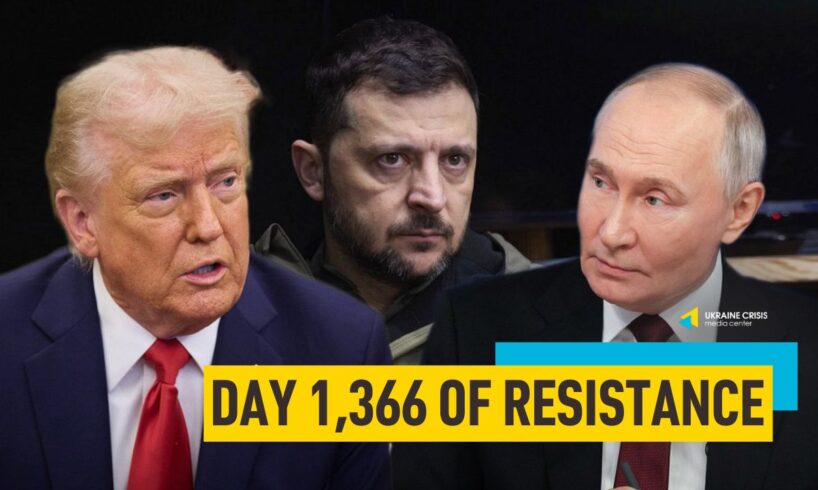
The 28-point peace plan mirrors Russia’s 2022 Istanbul demands, ISW says. EU officials oppose plans that could lead to Ukraine capitulation, Reuters says. EU imports from Russia exceed the bloc’s support for Ukraine by 124 billion euros, the Swedish foreign minister says.
28-point peace plan mirrors Russia’s 2022 Istanbul demands, ISW says
US and Russian officials reportedly drafted a 28-point peace plan that amounts to Ukraine’s full capitulation and would set conditions for renewed Russian aggression against Ukraine. The reported proposed peace plan would deprive Ukraine of critical defensive positions and capabilities necessary to defend against future Russian aggression, apparently in exchange for nothing, the Institute for the Study of War (ISW) said in an update on Thursday. The paragraphs below are quoted from the report.
Several Western media outlets reported on November 19 that US and Russian officials worked on a draft 28-point peace plan in Ukraine. The preponderance of the Western reporting suggests that the peace deal would require Ukraine to: withdraw from the unoccupied parts of Donetsk and Luhansk oblasts; cap its military at 50 percent of its current strength; abandon “key categories of weaponry;” and that Ukraine would receive unspecified US security guarantees.
Some of the Western reporting suggests that the deal would: prohibit foreign troop deployments to Ukraine; prohibit Ukraine from receiving foreign long-range weapons capable of striking deep into Russian territory; force Ukraine to make Russian an official state language; and force Ukraine to grant official status to the Russian Orthodox Church-Moscow Patriarchate (ROC-MP), which is a Kremlin-controlled organization and known tool of Russia’s hybrid warfare toolkit.
ISW continues to assess that ceding the remainder of Donetsk Oblast to Russia and freezing the frontline in southern Ukraine would disproportionately favor Russia. Donetsk Oblast contains land that is vital for Ukraine, including the Fortress Belt — Ukraine’s main defensive line in the oblast since 2014 — and includes cities that are vital defense, industrial, and logistics hubs for Ukrainian forces. Russia has attempted to seize Ukraine’s Fortress Belt unsuccessfully for over a decade, and ISW continues to assess that a Russian effort to seize the Fortress Belt would likely take several years at Russia’s current rate of advance.
The reported peace plan would give this significant land to Russia — apparently for no specified compromise — sparing Russia the time, effort, and manpower that it could use elsewhere in Ukraine during renewed aggression. Kremlin officials have previously stipulated that a withdrawal from Donbas would be the starting point rather than the result of ceasefire and peace negotiations, providing no guarantee of peace should Ukraine conduct such a withdrawal. The Kremlin has given no indication that it is willing to consider peace talks or a peace deal before Ukraine has withdrawn from the remainder of Donbas.
A Ukrainian withdrawal from Donetsk Oblast would also provide Russian forces with more advantageous positions from which to launch renewed pushes into southern Kharkiv Oblast and further into eastern Zaporizhia and Dnipropetrovsk Oblasts.[16] Such a withdrawal would also set conditions for Russian forces to advance across the Oskil River in eastern Kharkiv Oblast. Russian forces would likely seek to later threaten Kharkiv City from multiple fronts.
Freezing the frontline in southern Ukraine also presents Russian forces with an opportunity to rest and reconstitute for future pushes against Kherson or Zaporizhzhia cities, both of which the Kremlin and Russian officials have identified as objectives. Russia would therefore have its choice of multiple, mutually supportive offensive operations to undertake should Ukraine cede Donetsk Oblast to Russia and agree to freeze the frontline in southern Ukraine, especially if there is no meaningful security guarantee mechanisms to prevent future Russian aggression and if Ukraine concedes to Russia’s demand of reduced military size and capacity.
This reported peace plan is fundamentally the same as Russia’s 2022 Istanbul demands, which Russia presented to Ukraine when the circumstances on the battlefield appeared to favor Russia more heavily. Russia presented these demands to Ukraine in the first two months of the war when Russian forces were threatening Kyiv City from the north and northwest. The frontline situation has significantly shifted since the 2022 Istanbul negotiations, though Russia’s demands have not. Ukraine forced Russian forces to withdraw from northern Ukraine in April 2022, launched a counteroffensive and liberated significant swaths of Kharkiv Oblast in September to October 2022, and conducted a successful interdiction campaign in Summer 2022 that allowed Ukrainian forces to liberate west (right) bank Kherson Oblast in November 2022. Ukrainian forces have liberated over 50 percent of the territory Russian forces have seized since 2022 and have forced Russian forces to undertake grinding, attritional offensives and advance at a rate no faster than footpace.
Russia’s 2022 Istanbul demands would have amounted to Ukraine’s full capitulation and permanently prohibited Ukraine from joining NATO, imposed severe limitations on the Ukrainian military, and banned Ukraine from receiving Western military assistance without imposing any restrictions on the size or capability of Russian forces — all consistent with the known terms of the reported 28-point peace plan. The Kremlin has consistently demonstrated and outright stated that it remains committed to achieving its original war aims, including the reduction of Ukraine’s military such that Ukraine cannot defend itself against future Russian attacks. Russian narratives following the emergence of this new reported peace plan continue revolving around Russia’s commitment to these original war aims and efforts to convince the West and Ukraine that Russia can outlast the West and Ukraine in a war of attrition and that Russian victory is therefore inevitable.
Russia’s long-held demands are dependent on the false premise that a Russian battlefield victory is inevitable. Russian President Vladimir Putin has repeatedly outlined a theory of victory based on the premise that the Russian military and economy can outlast and overcome Western support for Ukraine and Ukraine’s own ability to continue defending against Russian aggression. Russian forces are currently making tactically-operationally significant advances in the Pokrovsk direction and are intensifying operations in some parts of the frontline, but are not advancing rapidly or achieving significant breakthroughs proportionate to the high losses they are suffering.
Ukrainian forces have also proven their ability to limit Russian mechanized advances across the theater, particularly when well-staffed and equipped. Ukrainian forces prevented Russian forces from making operationally significant advances and limited the areas where Russian forces managed to make tactically significant gains throughout 2023 and 2024.
Ukrainian forces are also actively rolling back Russian advances in Kupyansk, marking the first successful Ukrainian effort to push back a Russian effort to seize a settlement at this scale in recent years.
ISW continues to assess that timely and sufficient Western military assistance and weapon sales to Ukraine, in concert with strong US and other Western economic measures against Russia, can enable Ukraine to inflict more severe battlefield losses on Russia and therefore challenge Putin’s theory of victory.
EU officials oppose plans that could lead to Ukraine capitulation, Reuters says
European foreign ministers said on Thursday that any plan to end the war in Ukraine must include Ukrainians and Europeans after the U.S. floated a framework that would involve Kyiv giving up some of its land and weapons and curbing the size of its army.
The U.S. has signalled to President Volodymyr Zelenskiy that Ukraine must accept a U.S.-drafted framework to end the war with Russia that proposes Kyiv giving up territory and some weapons, two people familiar with the matter told Reuters on Wednesday. The paragraphs below are quoted from several Reuters pieces.
European Union foreign ministers meeting in Brussels did not comment in detail about the U.S. plan, but indicated they would not accept demands for Kyiv to make punishing concessions.
“Ukrainians want peace – a just peace that respects everyone’s sovereignty, a durable peace that can’t be called into question by future aggression,” said French Foreign Minister Jean-Noel Barrot. “But peace cannot be a capitulation.”
Arriving at the Brussels meeting on Thursday, Polish Foreign Minister Radoslaw Sikorski said Ukraine should not have its ability to defend itself limited. “I hope it’s not the victim that has restrictions on its ability to defend itself put on, but it’s the aggressor,” he said.
“What we as Europeans have always supported is a long-lasting and just peace, and we welcome any efforts to achieve that. Of course, for any plan to work, it needs Ukrainians and Europeans on board,” European Union foreign policy chief Kaja Kallas told reporters as she arrived for a meeting of EU foreign ministers in Brussels.
The Trump administration has been secretly working in consultation with Russia to draft a new plan to end the war in Ukraine, U.S. and Russian officials earlier told Axios. Trump’s envoy Steve Witkoff is leading the drafting of the plan and has discussed it extensively with Russian envoy Kirill Dmitriev, a U.S. official said.
The White House is on the brink of unveiling a major new peace agreement with Russia that officials say will finally bring the three-and-a-half year war with Ukraine to an end, Politico said on Thursday. A senior White House official tells Dasha [Politico’s White House Bureau Chief] they expect a framework for ending the conflict to be agreed by all parties by the end of this month — and possibly “as soon as this week.”
As part of the Turkish support for Trump’s peace initiative, Witkoff planned to visit Ankara on Wednesday and hold a trilateral meeting with Zelensky and Turkish Foreign Minister Hakan Fidan, a U.S. official told Axios on Thursday. A Ukrainian official said the meeting was postponed because Zelensky asked to discuss the plan in a broader format, including European countries. The sides supposedly had diverging views on preliminary agreements and elements of the plan.
Steve Witkoff’s “peace deal” looks like a Russian wish list, and Ukraine is not biting, The Economist said Wednesday.
EU imports from Russia exceed bloc’s support for Ukraine by 124 billion euros, Swedish foreign minister says
The EU’s imports of Russian goods and energy resources since the full-scale invasion exceeds the bloc’s support for Ukraine by 124 billion euros, Swedish Foreign Minister Maria Stenergard told reporters ahead of a meeting of the EU’s Foreign Affairs Council in Brussels on Thursday.
“The truth is the support to Ukraine is not big enough, but the support to Russia is too big,” Malmer Stenergard said.
Since the full-scale invasion, the European countries and the EU have provided 187 billion euros worth of support to Ukraine, she said.
“During the same period we have imported Russian oil and gas to an amount of 201 billion euros. If you add the other imports, than the total is 311 billion euros, meaning we end up on a negative support to Ukraine by 124 billion euros,” she explained while holding a chart illustrating the figures. “This is nothing but a disgrace,” she added.
“There will be no reasonable peace talks if we do not increase support to Ukraine and pressure on Russia. A very good start would be to use the frozen assets for the benefit of Ukraine,” Malmer Stenergard said.




